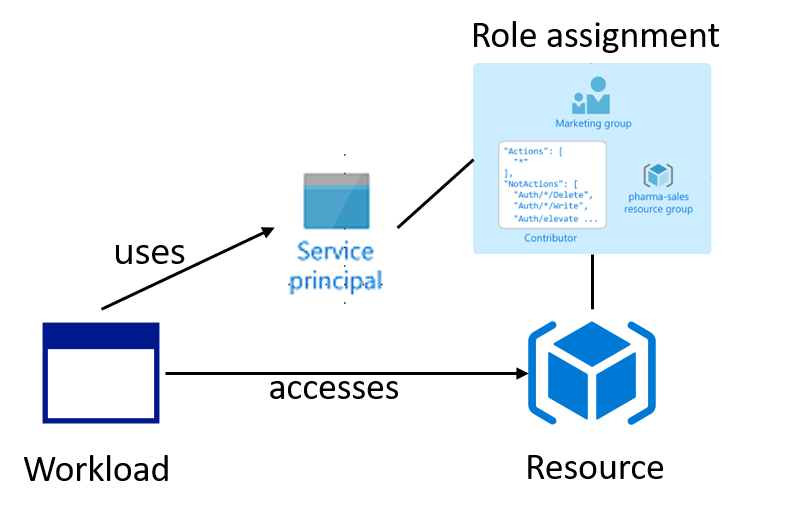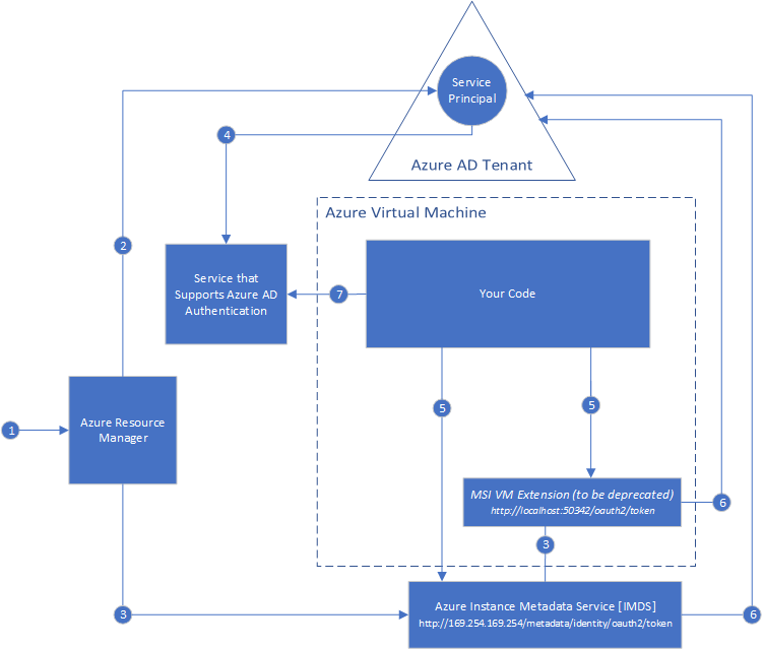Create a Kubernetes pod that uses Managed Service Identity (MSI) to access an Azure Key Vault
Here is what you learn
- Create a user-assigned managed identity
- Install aad-pod-identity in your cluster
- Create an Azure Key Vault and store credentials
- Deploy a pod that uses a user-assigned managed identity to access an Azure Key Vault
Access Azure resources in your workload
To access Azure resources in your workload, your workload must be authorized using a Service Principal.

Using a Service Principal means, that as a developer you have to store client id and client secret in your application settings. You are responsible for ensuring that this information does not fall into the wrong hands. In addition you have to do a rolling update for the key credential when it expires.
With Azure MSI (Managed Service Identity) you can assign an AAD identity to your workload that can be used to authorize access to Azure resources. Your workload can acquire an AAD token before acessing Azure resources. The created Service Principal is fully managed by Azure.

With AAD Pod Identity you can assign an AAD identity to your pod.

Deploy the aad-pod-identity infra in your existing cluster
Open a shell and run the following kubectl create command:
kubectl create -f https://raw.githubusercontent.com/Azure/aad-pod-identity/master/deploy/infra/deployment.yaml
If you have an RBAC enabled cluster run the following kubectl create command:
kubectl create -f https://raw.githubusercontent.com/Azure/aad-pod-identity/master/deploy/infra/deployment-rbac.yaml
Now you have NMI and MIC running in your cluster. To get a detailed description of NMI and MIC take a look here
Create an Azure user-assigned managed identity
Remember the client id, principal id and resource id for the identity.
az identity create -g <resource-groupname> -n <managedidentity-resourcename>
Now you have created a managed identity with the name managedidentity-name. Take a look at your resource group. The identity is listed as an Azure resource.
Assign Reader Role to the new created identity
Using the principal id from the last step, assign the reader role to the new created identity for the resource group.
az role assignment create --role Reader --assignee <principal-id> --scope /subscriptions/<subscriptionid>/resourcegroups/<resourcegroup>
Get your AKS Service Principal object id
If you don’t know the Service Principal that is used for your Cluster do the following:
az aks show -n <akscluster-name> -g <resource-groupname>
Rember the client id from the output under the section:
"servicePrincipalProfile": {
"clientId": "<client id>"
},
After that run the following command to get details of the Service Principal
az ad sp show --id <client id>
Remember the object id from the output.
"objectId": "<object id>"
Create permissions for MIC
MIC uses the service principal credentials stored within the the AKS cluster to access azure resources. This service principal needs to have Microsoft.ManagedIdentity/userAssignedIdentities/*/assign/action permission on the identity for usage with User assigned MSI.
Assign the required permission and use the object id from the previous step as sp id.
az role assignment create --role "Managed Identity Operator" --assignee <sp id> --scope <full id of the managed identity>
Create an Azure KeyVault
To demo AAD pod identity we create an Azure KeyVault and grant read access for the created user-assigned identity.
Create an Azure KeyVault in your resource group and remember the id from the output.
>az keyvault create -n <global unique name> -g <resource group> --sku standard
Set access ploicies for your user-assigned identity using the principal id from the step above.
>az keyvault set-policy -n <keyvault name> --object-id <principal id of your user-assigned identity> --secret-permissions get, list --key-permissions get, list --certificate-permissions get, list
Add some secrets to your key vault that we will be used later in the demo application. Do not change the name of the secrets!
>az keyvault secret set --vault-name <key vault name> --name Settings--ValueOne --value DemoValueOne
>az keyvault secret set --vault-name <key vault name> --name Settings--ValueTwo --value DemoValueTwo
Install Identity on your AKS Cluster
Edit and save the file aadpodidentity.yaml. Replace clientid and managed-identity-resourcename.
apiVersion: "aadpodidentity.k8s.io/v1"
kind: AzureIdentity
metadata:
name: demoidentity
spec:
type: 0
ResourceID: /subscriptions/<subid>/resourcegroups/<resourcegroup>/providers/Microsoft.ManagedIdentity/userAssignedIdentities/<managedidentity-resourcename>
ClientID: <clientid>
kubectl create -f aadpodidentity.yaml
Install Pod to Identity binding
Edit and save the file aadpodidentitybinding.yaml
apiVersion: "aadpodidentity.k8s.io/v1"
kind: AzureIdentityBinding
metadata:
name: demo1-azure-identity-binding
spec:
AzureIdentity: demoidentity
Selector: azureidentitydemo
kubectl create -f aadpodidentitybinding.yaml
To use the AzureIdentityBinding in your deployment you must use a label named aadpodidbinding and set its value to the value of the AzureIdentityBinding’s Selector value, e.g.:
labels:
aadpodidbinding: azureidentitydemo
Install demo application
There is already a demo application implemented in ASP.NET Core to demo the usage of AAD Pod Identity. The application is a simple REST API that loads its settings from the above created Azure key vault. You can find the application here. The application uses the Options Pattern to load application settings into a simple object.
public class SettingsOptions
{
public string ValueOne { get; set; }
public string ValueTwo { get; set; }
}
The binding from the settings to the SettingsObject is configures in Startup.cs.
services.Configure<SettingsOptions>(options => Configuration.Bind("Settings", options));
To load settings from an Azure key vault, ASP.NET Core must be configured in Program.cs
public static IWebHostBuilder CreateWebHostBuilder(string[] args) =>
WebHost.CreateDefaultBuilder(args)
.UseStartup<Startup>()
.ConfigureAppConfiguration((ctx, builder) =>
{
var config = builder.Build();
var kvurl = config["KeyVault:BaseUrl"];
var tokenProvider = new AzureServiceTokenProvider();
var kvClient = new KeyVaultClient((authority, resource, scope) => tokenProvider.KeyVaultTokenCallback(authority, resource, scope));
builder.AddAzureKeyVault(kvurl, kvClient, new DefaultKeyVaultSecretManager());
});
You can see that a special component named AzureServiceTokenProvider is used. This component is responsible to acquire a token on behalf of your user-assigned identity to access the Azure key vault.
Now its time to build the docker image for the demo application. Open a shell and go to the directory where the dockerfile is located and run the following command to create the image.
docker build -t aadpodidentitydemoapi:1.0 .
Now tag your image to push it to your Azure Container Registry
docker tag aadpodidentitydemoapi:1.0 <your registryname>.azurecr.io/aadpodidentitydemoapi:1.0
Login to your Azure Container Registry instance.
az acr login -n <your registry name> -g <resourcegroup name>
Push the image to your registry.
docker push <your registry name>.azurecr.io/aadpodidentitydemoapi:1.0
Deploy the Demo Application.
Open the deployment yaml-file and replace the value of the environment variable KeyVault__BaseUrl with the url of your key vault and specify the secret to access your Azure container registry.
apiVersion: extensions/v1beta1
kind: Deployment
metadata:
name: aadpodidentitydemoapibackend
spec:
replicas: 3
minReadySeconds: 5
strategy:
type: RollingUpdate
rollingUpdate:
maxSurge: 1
maxUnavailable: 1
template:
metadata:
labels:
name: aadpodidentitydemoapibackend
app: aadpodidentitydemoapi
aadpodidbinding: azureidentitydemo
spec:
containers:
- name: aadpodidentitydemoapi
image: anmock.azurecr.io/aadpodidentitydemoapi:1.0
env:
- name: KeyVault__BaseUrl
value: "<your keyvault url e.g.: https://myvault.vault.azure.net>"
ports:
- containerPort: 80
name: http
protocol: TCP
imagePullSecrets:
- name: <your docker-registry secret>
Run the kubectl apply command.
kubectl apply -f .\demoapi.yaml
Get the IP address of the demoapi service using kubectl.
kubectl get service
NAME TYPE CLUSTER-IP EXTERNAL-IP PORT(S) AGE
aadpodidentitydemoapisvc LoadBalancer 10.0.206.148 <public IP> 80:32073/TCP 1d
Open a browser and navigate to http://<public IP>/swagger and try out the GET http request /api/settings. The values stored in your key vault are returned.
{
"valueOne": "DemoValueOne",
"valueTwo": "DemoValueTwo"
}